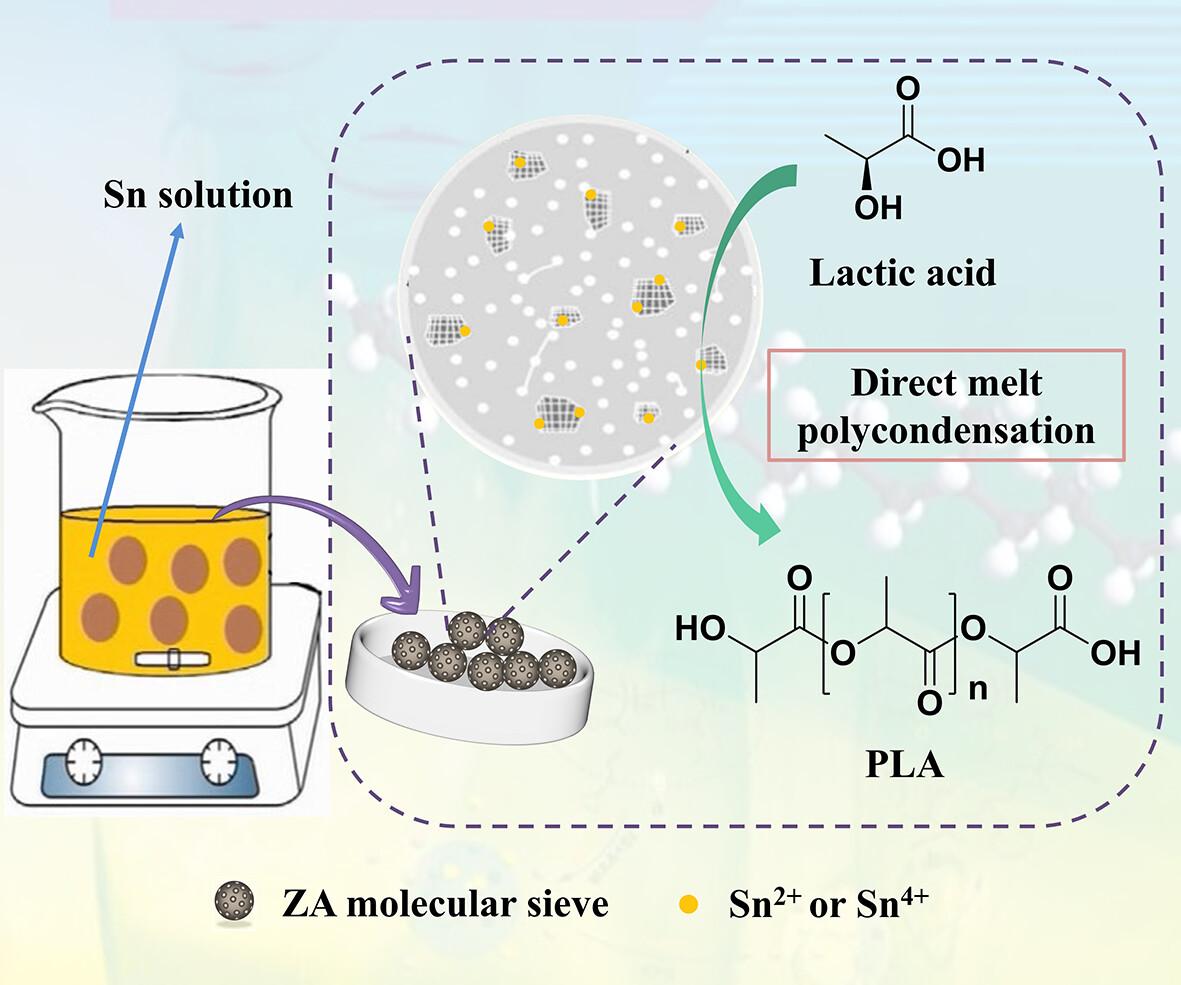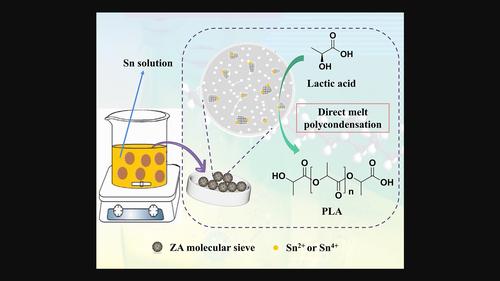求助PDF
{"title":"以非食品类生物质为原料,用负载锡的ZA分子筛催化剂直接熔融缩聚合成聚乳酸","authors":"Chengtao Gao, Yanwen Wang, Yunlong Yang, Shuhao Qin","doi":"10.1002/pi.6594","DOIUrl":null,"url":null,"abstract":"<p>The design and synthesis of catalysts loaded with active components has attracted considerable attention in current research owing to their exceptional catalytic performance. In this study, the focus was on the utilization of tin-loaded ZA molecular sieves, possessing remarkable adsorption properties, alongside the catalytic activity of tin. These catalysts were successfully prepared and employed for the synthesis of poly(lactic acid) (PLA) from lactic acid derived from non-food biomass. By modifying the treatment of ZA molecular sieves, the properties of tin-loaded ZA molecular sieves were adjusted. The resulting catalysts exhibited a high tin capacity ranging from 2.29% to 2.81% and featured abundant mesoporous structures, providing a surface area of up to 341.2 m<sup>2</sup> g<sup>−1</sup>. Regarding the preparation of PLA, our findings demonstrated that ZA-III-Sn<sup>2+</sup> as a catalyst yielded PLA with a higher weight-average molecular weight (<i>M</i><sub>w</sub>) up to 2.57 × 10<sup>4</sup> g mol<sup>−1</sup> and a higher yield of 65.3% compared to other catalysts. Moreover, the most optimal catalytic effect was achieved by adding the catalyst in three separate stages. Moreover, the amount of catalyst, reaction temperature and reaction time were found to influence both the molecular weight and yield of PLA. This study not only provides a valuable strategy for the preparation of loaded catalysts for PLA production but also offers new insights into the overall preparation process of PLA. © 2023 Society of Industrial Chemistry.</p>","PeriodicalId":20404,"journal":{"name":"Polymer International","volume":"73 4","pages":"310-318"},"PeriodicalIF":3.6000,"publicationDate":"2023-11-20","publicationTypes":"Journal Article","fieldsOfStudy":null,"isOpenAccess":false,"openAccessPdf":"","citationCount":"0","resultStr":"{\"title\":\"Poly(lactic acid) synthesized from non-food biomass feedstocks with tin-loaded ZA molecular sieve catalysts by direct melt polycondensation\",\"authors\":\"Chengtao Gao, Yanwen Wang, Yunlong Yang, Shuhao Qin\",\"doi\":\"10.1002/pi.6594\",\"DOIUrl\":null,\"url\":null,\"abstract\":\"<p>The design and synthesis of catalysts loaded with active components has attracted considerable attention in current research owing to their exceptional catalytic performance. In this study, the focus was on the utilization of tin-loaded ZA molecular sieves, possessing remarkable adsorption properties, alongside the catalytic activity of tin. These catalysts were successfully prepared and employed for the synthesis of poly(lactic acid) (PLA) from lactic acid derived from non-food biomass. By modifying the treatment of ZA molecular sieves, the properties of tin-loaded ZA molecular sieves were adjusted. The resulting catalysts exhibited a high tin capacity ranging from 2.29% to 2.81% and featured abundant mesoporous structures, providing a surface area of up to 341.2 m<sup>2</sup> g<sup>−1</sup>. Regarding the preparation of PLA, our findings demonstrated that ZA-III-Sn<sup>2+</sup> as a catalyst yielded PLA with a higher weight-average molecular weight (<i>M</i><sub>w</sub>) up to 2.57 × 10<sup>4</sup> g mol<sup>−1</sup> and a higher yield of 65.3% compared to other catalysts. Moreover, the most optimal catalytic effect was achieved by adding the catalyst in three separate stages. Moreover, the amount of catalyst, reaction temperature and reaction time were found to influence both the molecular weight and yield of PLA. This study not only provides a valuable strategy for the preparation of loaded catalysts for PLA production but also offers new insights into the overall preparation process of PLA. © 2023 Society of Industrial Chemistry.</p>\",\"PeriodicalId\":20404,\"journal\":{\"name\":\"Polymer International\",\"volume\":\"73 4\",\"pages\":\"310-318\"},\"PeriodicalIF\":3.6000,\"publicationDate\":\"2023-11-20\",\"publicationTypes\":\"Journal Article\",\"fieldsOfStudy\":null,\"isOpenAccess\":false,\"openAccessPdf\":\"\",\"citationCount\":\"0\",\"resultStr\":null,\"platform\":\"Semanticscholar\",\"paperid\":null,\"PeriodicalName\":\"Polymer International\",\"FirstCategoryId\":\"92\",\"ListUrlMain\":\"https://onlinelibrary.wiley.com/doi/10.1002/pi.6594\",\"RegionNum\":4,\"RegionCategory\":\"化学\",\"ArticlePicture\":[],\"TitleCN\":null,\"AbstractTextCN\":null,\"PMCID\":null,\"EPubDate\":\"\",\"PubModel\":\"\",\"JCR\":\"Q2\",\"JCRName\":\"POLYMER SCIENCE\",\"Score\":null,\"Total\":0}","platform":"Semanticscholar","paperid":null,"PeriodicalName":"Polymer International","FirstCategoryId":"92","ListUrlMain":"https://onlinelibrary.wiley.com/doi/10.1002/pi.6594","RegionNum":4,"RegionCategory":"化学","ArticlePicture":[],"TitleCN":null,"AbstractTextCN":null,"PMCID":null,"EPubDate":"","PubModel":"","JCR":"Q2","JCRName":"POLYMER SCIENCE","Score":null,"Total":0}
引用次数: 0
引用
批量引用



 求助内容:
求助内容: 应助结果提醒方式:
应助结果提醒方式:


